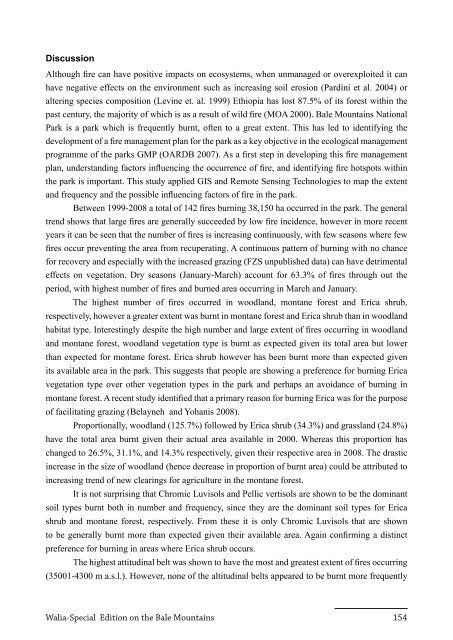Walia Special Edition on the Bale Mountains (2011) - Zoologische ...
Walia Special Edition on the Bale Mountains (2011) - Zoologische ...
Walia Special Edition on the Bale Mountains (2011) - Zoologische ...
You also want an ePaper? Increase the reach of your titles
YUMPU automatically turns print PDFs into web optimized ePapers that Google loves.
Discussi<strong>on</strong><br />
Although fire can have positive impacts <strong>on</strong> ecosystems, when unmanaged or overexploited it can<br />
have negative effects <strong>on</strong> <strong>the</strong> envir<strong>on</strong>ment such as increasing soil erosi<strong>on</strong> (Pardini et al. 2004) or<br />
altering species compositi<strong>on</strong> (Levine et. al. 1999) Ethiopia has lost 87.5% of its forest within <strong>the</strong><br />
past century, <strong>the</strong> majority of which is as a result of wild fire (MOA 2000). <strong>Bale</strong> <strong>Mountains</strong> Nati<strong>on</strong>al<br />
Park is a park which is frequently burnt, often to a great extent. This has led to identifying <strong>the</strong><br />
development of a fire management plan for <strong>the</strong> park as a key objective in <strong>the</strong> ecological management<br />
programme of <strong>the</strong> parks GMP (OARDB 2007). As a first step in developing this fire management<br />
plan, understanding factors influencing <strong>the</strong> occurrence of fire, and identifying fire hotspots within<br />
<strong>the</strong> park is important. This study applied GIS and Remote Sensing Technologies to map <strong>the</strong> extent<br />
and frequency and <strong>the</strong> possible influencing factors of fire in <strong>the</strong> park.<br />
Between 1999-2008 a total of 142 fires burning 38,150 ha occurred in <strong>the</strong> park. The general<br />
trend shows that large fires are generally succeeded by low fire incidence, however in more recent<br />
years it can be seen that <strong>the</strong> number of fires is increasing c<strong>on</strong>tinuously, with few seas<strong>on</strong>s where few<br />
fires occur preventing <strong>the</strong> area from recuperating. A c<strong>on</strong>tinuous pattern of burning with no chance<br />
for recovery and especially with <strong>the</strong> increased grazing (FZS unpublished data) can have detrimental<br />
effects <strong>on</strong> vegetati<strong>on</strong>. Dry seas<strong>on</strong>s (January-March) account for 63.3% of fires through out <strong>the</strong><br />
period, with highest number of fires and burned area occurring in March and January.<br />
The highest number of fires occurred in woodland, m<strong>on</strong>tane forest and Erica shrub,<br />
respectively, however a greater extent was burnt in m<strong>on</strong>tane forest and Erica shrub than in woodland<br />
habitat type. Interestingly despite <strong>the</strong> high number and large extent of fires occurring in woodland<br />
and m<strong>on</strong>tane forest, woodland vegetati<strong>on</strong> type is burnt as expected given its total area but lower<br />
than expected for m<strong>on</strong>tane forest. Erica shrub however has been burnt more than expected given<br />
its available area in <strong>the</strong> park. This suggests that people are showing a preference for burning Erica<br />
vegetati<strong>on</strong> type over o<strong>the</strong>r vegetati<strong>on</strong> types in <strong>the</strong> park and perhaps an avoidance of burning in<br />
m<strong>on</strong>tane forest. A recent study identified that a primary reas<strong>on</strong> for burning Erica was for <strong>the</strong> purpose<br />
of facilitating grazing (Belayneh and Yohanis 2008).<br />
Proporti<strong>on</strong>ally, woodland (125.7%) followed by Erica shrub (34.3%) and grassland (24.8%)<br />
have <strong>the</strong> total area burnt given <strong>the</strong>ir actual area available in 2000. Whereas this proporti<strong>on</strong> has<br />
changed to 26.5%, 31.1%, and 14.3% respectively, given <strong>the</strong>ir respective area in 2008. The drastic<br />
increase in <strong>the</strong> size of woodland (hence decrease in proporti<strong>on</strong> of burnt area) could be attributed to<br />
increasing trend of new clearings for agriculture in <strong>the</strong> m<strong>on</strong>tane forest.<br />
It is not surprising that Chromic Luvisols and Pellic vertisols are shown to be <strong>the</strong> dominant<br />
soil types burnt both in number and frequency, since <strong>the</strong>y are <strong>the</strong> dominant soil types for Erica<br />
shrub and m<strong>on</strong>tane forest, respectively. From <strong>the</strong>se it is <strong>on</strong>ly Chromic Luvisols that are shown<br />
to be generally burnt more than expected given <strong>the</strong>ir available area. Again c<strong>on</strong>firming a distinct<br />
preference for burning in areas where Erica shrub occurs.<br />
The highest attitudinal belt was shown to have <strong>the</strong> most and greatest extent of fires occurring<br />
(35001-4300 m a.s.l.). However, n<strong>on</strong>e of <strong>the</strong> altitudinal belts appeared to be burnt more frequently<br />
<str<strong>on</strong>g>Walia</str<strong>on</strong>g>-<str<strong>on</strong>g>Special</str<strong>on</strong>g> <str<strong>on</strong>g>Editi<strong>on</strong></str<strong>on</strong>g> <strong>on</strong> <strong>the</strong> <strong>Bale</strong> <strong>Mountains</strong> 154
















